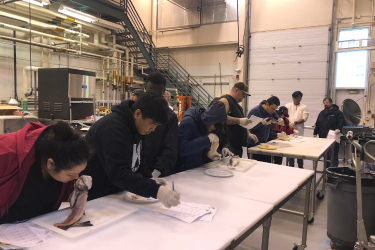NOAA Fisheries and the Gulf States Marine Fisheries Commission are encouraging the early adoption of a new system to update the data collection process for Gulf of America (formerly Gulf of Mexico) shrimping effort. The new system will greatly increase the quality and efficiency of data collected to describe the Gulf shrimp commercial fleet.
Why Do We Collect Effort Data?
The shrimp industry is culturally iconic, and an economic driver for Gulf of America coastal communities. In fact, it is the most valuable commercial species in the Gulf of America. To ensure the fishery is sustainable in the long-term, fishery managers require information on the amount of fishing effort taking place to complete annual stock assessments for shrimp and other species. These effort data also help conserve protected species. It can also be used to minimize conflicts with other industries, such as wind energy, by identifying important shrimping grounds so the resources shrimpers depend on can be preserved.
How Do We Collect These Data?
Until recently, shrimp effort data were collected through a cellular electronic logbook system. This system transmitted time-stamped vessel position data using a 3G cellular network to our scientists. However, 3G cellular technology was shut down in December 2020—driving the need for a modernized data collection protocol. Since this change, shrimpers have been physically sending in memory cards for data retrieval. Thankfully, there’s now a better way.
Benefits of the New System
The new system involves installing cellular vessel monitoring system units on board federally permitted shrimp vessels with Gulf of Mexico Shrimp Permits. The devices transmit vessel position data directly to the Southeast Fisheries Science Center via current cellular networks. This allows scientists to estimate shrimping effort more efficiently, and provide benefits for individuals in the industry. Depending on the device installed, shrimp vessel owners can choose to access applications that allow them to view vessel position in near real-time if within cellular range, and save them for comparison.
What Data Will the System Collect?
The new devices track time-stamped vessel position every 10 minutes to determine how much time is spent towing nets versus steaming to fishing grounds. This is converted to an estimate of effort in tow days. These effort data are used directly in stock assessments to better manage shrimp and other fisheries. This information is also essential for meeting sea turtle conservation requirements. Position information also helps scientists identify important shrimping grounds that need to be taken into consideration in marine spatial planning to avoid conflicts with other ocean industries like wind energy and aquaculture.
How This Came About
The funds for this program were appropriated by Congress for NOAA Fisheries. With this funding, we worked with the Gulf States Marine Fisheries Commission and LGL Ecological Research Associates, Inc. to test the new system. The team outfitted five federally permitted commercial shrimp vessels in Palacios, Texas with new devices alongside the existing devices. Results show that the new devices collected data as reliably as the old ones and successfully transmitted data to NOAA Fisheries.
“We hope the new system will modernize the data collection and allow us to ‘beta test’ a number of devices to inform the Gulf Council on what could eventually become the new standard for shrimp effort data collection”, said John Walter, Deputy Director for Science and Council Services at the NOAA Fisheries Southeast Fisheries Science Center.
How to Sign Up
The new devices are now available at no cost to Gulf of Mexico Shrimp Permit holders. The program will cover the cost for a limited number of cellular vessel monitoring system units, installation and maintenance, and 2 years of cellular service for the new device. We are seeking volunteers for this early adopter program through September 30, 2024. Support through the early adopter program is available on a first come, first serve basis.
The Gulf States Marine Fisheries Commission has contracted with LGL Ecological Research Associates, Inc. to coordinate the early adopter phase of this effort modernization project.
Early adopters must hold a Gulf of Mexico Shrimp Permit. Interested parties should contact LGL Ecological Research Associates:
Nathan Putman
Email: nputman@lgl.com
Cell: (205) 218-5276
Office: (979) 846-7000



